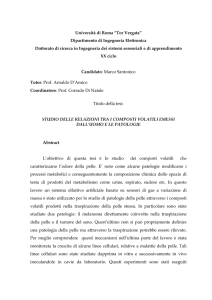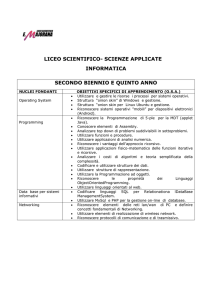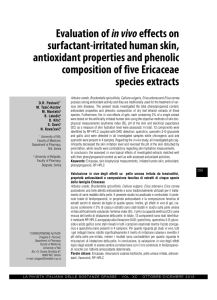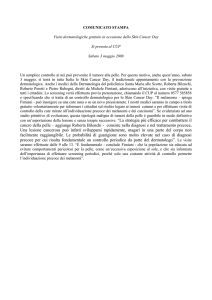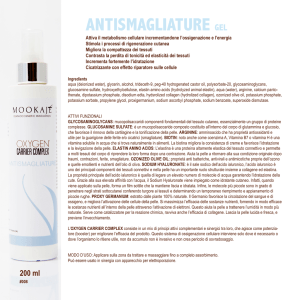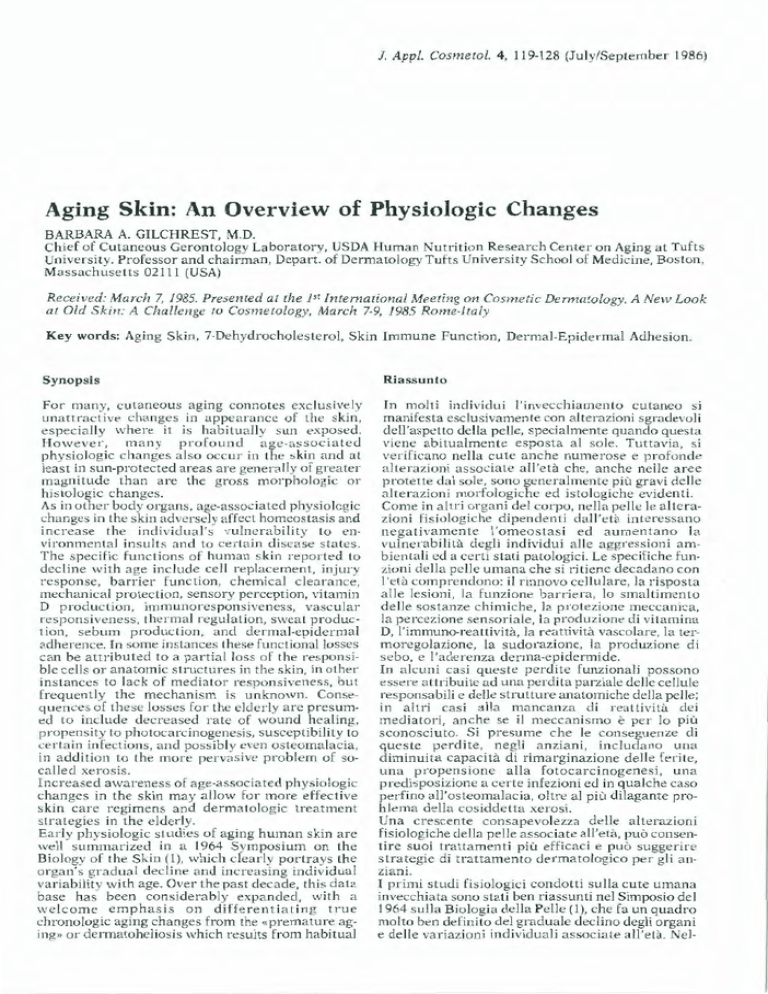
J. A pp /. Cosmetol. 4, 119- 128 (July/September 1986)
Aging Skin: An Overview of Physiologic Changes
BARBARA A. GILCH REST, M.D.
Chie f of Cut aneous Geronto logy Labo ratory, USDA Hu man Nutrition Research Center o n Aging a l Tu fts
Unive rsity. Professo r a ncl cha irma n, Depa n . of Dermatolo gy Tufts Universi ty School of Medicine, Bos to n,
Massachu se t ts 02 1 I t (USA)
R eceived: Ma rch 7, 1985. Presented a l the Jst In te rna1io 11a / Meeting on Cos111e1ic Dermatology. A New Look
a l Old Skin: A Challenge lo Cos111etology, Ma rch 7-9, 1985 Rom e-l taly
Key words: Aging S kin , 7-Dehyclrocholesterol, S kin Immu ne Funct ion, Derma l-Epicle rma l Aclhesion.
Synopsis
Fo r ma ny, c u taneo us aging connotes exc lus ivc ly
unatt rac tive c hangcs in appcarance or the skin,
espec ia lly whe re it is habitually sun exposecl.
Howevcr, ma ny pro founcl age-associa te cl
physiologic c hanges also occ u r in the skin ancl a t
least in sun-pro tectecl a reas are generally of g reater
magni tucle than a re the gross morpho logic o r
his to logic changes.
As in ot hcr body o rgans, age-associatecl phys io logic
cha nges in the skin aclvcrsely affcct homeostasis ami
in c rcasc the incli viclua l's vulne rabil ity Lo e nvi ro nmcntal in sul ts a ncl to ccr tai n cliscase s ta tes.
Thc spcc ifi c func tions of human sk in reportccl to
clccl ine with age include ccli rcplacement, inj ury
responsc, ba r r ier fu nct ion, chcm ical clearance,
mechanical protectio n, sensory perception, vitam in
D productio n, imm uno responsiveness, vascu la r
rcsponsiveness, the rma l rcgul a t ion, swea t p1·oduct ion, sebu m production, a nd clerma l-epide rmal
aclherence. In some in stances these f unct ion al losses
can be al t ribu ted to a part ial loss of the respons ible cell s o r ana tom ie structu res in the skin, in o ther
instances to lack of me d ia to r respons iveness, bu t
frequcnt ly the mec han ism is un known. Consequenccs of t hese losses fo r the eldcrly a re presu med to inc lude clecreased rate of wound heali ng,
p ropensity to pho tocarcinogenesis, susceptibility to
certain infections, and possibly even osteomalacia,
in additio n 10 the more pervasive problem of socalled xerosis.
l nc reasecl awareness of age-assoc ia 1ed physiologic
changes in the skin may a llow for mo re effective
ski n ca re regimens a nd de rmato log ie t reatment
stra tegies in the e lder ly.
Earl y phys io logic studi es of aging h uma n s kin a re
we ll sum marized in a 1964 Symposium on th e
Biology of the Sk in ( 1), which clearly por trays the
o rgan's graduai decline and inc reasing ind ividuai
variabil ity wi th age. Over the past decade, this data
base has been considerably expanded, w ith a
welco m e e m phas is o n d iffe ren ti at ing true
chronologic aging cha nges from the «prematu re aging» or dermatohel iosis which rcsu lts from habitua l
Riassunto
In mo lti individui l' in vecchia mento cu ta neo s i
manifesta esclusivamente con alterazioni sgradevoli
de ll 'aspetto del la pelle, specialmente q ua ndo questa
viene abitualme nte esposta al sole. Tu ttavia, si
veri fica no ne lla cu te anc he n umerose e profonde
al te razioni associa te all 'e tà c he. a nche nelle aree
protelle da l sole, sono gene ra lme nte più gravi delle
a lteraLioni morfo logiche ed istologic he eviden ti .
Come in al t ri o rgani ciel corpo, ne lla pelle le a lteraLioni fis io logiche d ipen de nt i d a ll 'età interessano
negat iva men te l'o meos tas i e d a ume nta no la
vulne rabi li tà degli in d ivid ui a ll e a gg ress ion i a mbienta li cd a certi stat i patologici. Le spec ifiche funzio ni de ll a pe lle umana c he si ritiene decadano con
l'età com prendono: il rinnovo cellul are, la r isposta
alle lesioni, la fun zione baniera, lo smaltimento
de lle sos tanze c him iche, la protezione meccanica,
la percezione sensori a le, la produzio ne di vitamina
D, l'immuno-r·eatt ivi tà, la reattività vascolare, la te rmoregolazione, la sudorazione, la produzio ne cli
sebo. e l'ade renza derma-epidermide.
In a lcun i cas i queste perdi te fun ziona li possono
essere attribu ite ad una perd ita pa rziale de lle ce llu le
responsabili e delle st rutture anatomiche dell a pelle;
in altri casi a lla mancanza cli reattività de i
med iato ri, anche se il meccani smo è per lo più
sconosciu to. Si presume che le conseguenze di
queste perdite, negl i a nzia ni , incl udano una
d iminu ita capacità d i rimarginaz io ne delle fer ite,
una propens ione alla fotoca rc inoge nesi, una
pred ispos izione a certe infezio ni ed in q ua lche caso
perfino a ll 'osteoma lacia, o ltre a l più d ilaga nte prob le ma de lla cosid de tt a xe rosi.
Una c rescente consapevolezza de lle a lteraz ion i
fisiologiche de lla pe lle associate a ll'età, può consentire suoi tra ttamenti pi ù effi caci e può suggerire
s t rategie di tratta mento derma tologico per g li ant iani.
! primi stud i fis io logici cond o tt i su lla cute u mana
invecchiata sono sta ti ben riassunti nel Simposio de l
1964 sulla Bio logia de lla Pel le ( 1), che fa un quadro
molto ben definito del graduale decl ino degli organi
e delle variazion i ind ividua li associa te a ll 'età. Nel-
120
sun exposure of the s kin (2). The fo llowing sections
concern the major cutaneous functions reported to
decline with ad vancing age, independent of sun exposure.
Prolife ration and Re pair
An age-associated decr ease in epiderma l
turnover rate of app roxim a tely 30-50 %
between the third a nd eighth decades of
!ife has been determined by a study of
d esquamation r a tes for corneocytes at
selected body s ites (3, 4). Sim ilar r esul ts
in a single study of desqua mation rates
fo r scalp corneocytes in patie nts w ith
dandruff su gge st that keratinocytes p roliferative capac ity decreases w ith age in
disea sed as well as in normai skin (3).
Thymidine labelling index of the epidermis in vivo ha s been re ported to decline
nearly 50% wi th age, from approxima te ly 5.1 % in 19-25 year old m en to a pproximately 2.8% in 69-85 year old m en (5).
Othe r investiga to r s have repor ted a c orrespood 100% prolongation in s trat um
corneum replacem e nt ra te in old vs .
young m en (6).
Repa ir r ate in s kin likewise declines w ith
age wh en me asure d by any of severa!
pa ra m eters (7-9). The mos t exten s ive of
these s tudies c ompa r ed th e r ate of
s t ratum corneum recons titution in 12
s ubjects aged 18-25 year s to tha t in 12
s ubjects aged 65-75 years (1 0). Subcorneal
bliste rs were raised by topica! a pplication of an am monium hydroxide solution,
the blister roofs excised, and th e resulting
wound repeatedly observed unti! normai
skin su r face markings wer e restored .
This p rocess r equir ed a m ed ian of app roxima tely 3 week s in the young subjects b u t 5 weeks in the old subjects.
Neoplasia is associated with aging in virtua lly a li organ sys tem s, but is especially characteris tic of the skin. One or m or e
benign prolifera tive cutaneous growths is
pr esen t in nearly every a dult beyond age
Aging skin: an Overview of Physiologic Changes
lo scor so decennio questa base d i dati è s tata notevolmente am pliata, e è stato posto un accen to opportu no sulla d is tinzione tra vere alterazio ni veramente cronologiche, «invecchiame nto prematu ro»
e dermatoeliosi conseguente ad una abitua le espo·
s izione della pe lle al sole (2). Le seguenti sezion i rigua rda no le maggio ri funzion i cu tanee che s i r it iene decadano con l'età, ind ipendentemente dall'espos izione a l sole.
P roliferazione e riparazione
In uno stu dio sui tassi di desqua mazione
dei corneociti r ilevati in zone seleziona te del corpo si è determi na to che tra il terzo e l'ottavo decennio di vi ta il tasso di
ricambio epidermico associato all'età diminuisce di circa il 30-50 %. Ana logh i ris ultati ottenuti in uno s tudio sui tassi di
d esqu amazione dei corneociti del cuo io
capelluto in pazienti affet ti d a forfora
s uggerisce che la capacità p roli fe rativa
dei che ra tinoc iti d im inuisce con l'età s ia
nella cu te a lterata ch e in q ue lla normale
(3). Si è osser vato che l'indice di timidina
m arcata dell 'epidermide in vivo declina
d i circa il 50 % con l'e tà , da un valore d i
c irca 5, 1% in soggetti d i 19-25 ann i fino
a circa il 2,8% in soggetti di età compresa tra 69 e 85 anni (5). Altr i r icer catori
h a nno dimost rato ch e il turn-over dello
s trato corneo si rallenta d el 100% negli
a nziani r ispe tto ai giovani (6).
Con va r i pa r a metr i, r isulta in modo an alogo che il tasso di ripar azione della pelle declina con l'età. Il più comple to ed
esauriente tra questi s tudi h a messo a
confronto il tasso di ricostituzione de llo
s tra to corneo in 12 sogget ti di e tà compresa tra 18 e 25 a nni con que llo d i sogget ti di età compresa tra 65 e 75 an ni (10).
Con applicazione locale di una soluzione
di idrossido di ammonio s i son o indotte
de lle vesciche a livello del corneo; sono
state poi incise e la ferita è s tata tenu ta
in osservazion e fino a completo ripristin o della norma le superficie cu tanea. Que-
A. Barbara, M.D. Gilchrest
65 years (11), a nd mos t individuals have
dozens of lesions. Malignant cutaneous
neoplasms, specifica lly basal celi carcinoma and squamous celi carcinoma,
are indisputably the most common
human m a lignancies. The benign a nd
malignant c utaneous neoplasm s almost
certainly re flect in part the loss of proliferative homeostasis with age (12). In
the case of skin cancer s, age-associated
reduction in DNA repair capaci ty a nd
decreased immunosurveillance may compound increased cumulative exposu re to
causative carcinoge ns a nd increased induction times following such exposures .
Barrier Function and Solute Transfer
The ba rrier func tion of intact stratum
corneum appears to decline with age in
the case of at least some substances (13),
a lthough t h e presum a bly kindred
phenomenon of tra nsepidermal water
loss does not vary with age in normai
a dul t skin (5). Aging also is accompanied
by a decreased clearance of t ransepidermally absorbed materials from the d ermis (13), proba bly due to alteration s in
the vascul ar bed and extra-cellular
matrix. Intradermally-injecte d saline h as
a lso been reported to resorb more slowly from young than from old skin (25), and
s imilar impairment of solute transfer between the extravascular and intravascula r
d erma! compartments has been su ggested in other systems as well, although
it is often difficult to isolate the vascular
component in a complex infla mmatory
reaction. In one study of cutaneous
respon se to topically applies ammonium
h ydroxide solution, perifollicular vesicles
appeared earlier in old a dult skin tha n in
young a dult skin, consistent with either
a reduced stratum corneum barrier or increased shunting of the irritant materiai
121
s to processo ha richiesto una m edia di
circa tre settimane per i soggetti giovani, e di cinque settimane per i soggetti anziani.
La neoplasia è associata all'invecchiamento praticamente in tutti i sis temi di
organi, ma è caratteristica specifica della pelle. In quals iasi adulto di età superiore ai 65 anni (11), si possono osservar e una o più crescite c uta nee proliferative benigne, e m olti individui presentano
decine di lesioni. Le n eoplasie c utaneee
maligne, e precisamente il carcinoma
cellulo-basale e il carcinoma cellulosquamoso, sono indubbiamente i più comuni tumori m a ligni umani. Le neopl as ie c utanee benigne e maligne quasi certa mente riflettono in parte la p erdita di
omeostasi proliferativa associata con l'età (12).
Nel caso dei tumori cutanei, la riduzione
d ella capacità di riparazione del DNA associa ta con l' età e la diminuzione
dell'immuno-sorveglianza possono a umentare le esposizioni a lle sostanze carc inoge ne tich e a umentando anche i tempi di induzione che seguono tali esposizioni.
Funzione barriera e trasferimento del soluto
La funzione barriera dello strato corneo
sembra ridursi con l'età, almeno n el caso di alcune sostanze (13), sebbe ne il fenomeno probabilmente a d esso collegato della perdita transepidermica di acqua
non subisca variazioni con l'età, n ella cute norma le d ell'adulto (5). L'invecchiamento è, inoltre, accompagnato da una diminuzione da parte del derma de lla sua
capacità di eliminazione dei materiali assorbiti a livello transepidermico (13), probabilmente in conseguenza di alterazioni che si verificano nel letto vascolare e
122
through appendageal o rifices, b ut the
t ime req uired afte r vesiculation fo r
development of a tense bliste r averaged
near ly twice as lon g in the o lder
vo luntee r group, s uggesting a dec reased
transidation rate with age in injured skin
( 14).
Responsiveness to External Stimuli
Decreased sensory perception in o ld skin
has been docume nted by severa! techniq ues, including optima l s timulu s in
grams for light touc h, cornea! sensa tion ,
and cutaneous pa in thres ho ld (15- 19).
Spontaneous ecc rin e swea tin g in
res po nse to dry hea t is reduced more
tha n 70 % in healthy old s u bjects as com pa red to young cont rols, a ttri butable
primarily to a decreased output per gland
(20, 2 1). Se bum production decreases by
a s imilar amount during adulthood,
a lthough thi s decrease is attrib utable
more to decreased androge n production
tha n to primary c uta neo us changes (22).
Age-assoc iat ed decreased vasc ul a r
respons iveness has been docume nted b y
clinically assessing vasodi la tion and transudation af te r appli cation of standardi zed irr itan ts, histamine, and the mast cell
degranul ating agent 40/80 to young and
o ld skin (23). Inte nsity o f ery thema
fo llowing a standardized ult raviolet exposure is a lso decreased w ith age and
normai skin (24), a ltho ug h as in the
previous in s tances factors o ther tha n
s im p le decreased vasc ul ar responsive ness may be responsible. Compromise d thermal regulation, which predisposes
the e lde rl y to hypothermia and possibly
to heat stroke may be due in part to
r educed vasodilatory o r vasoconstrictor
capacity of derma! arterio les, in part to
decreased eccrine sweat productio n, and
i n part to loss of s ubc u taneo us fat, a li of
whic h occu r w ith adva nc ing age.
Aging skin: a n Ove1-view of Physiologic Changes
nella matrice extra-cellulare. Si è, inoltre,
osservato che una soluzione sa lina inie ttata pe r via intradermica viene riassorbita più lentamente dalla cu te giovane
c he non da quella invecchiata (25), come
sembra essere sta to a nche assoda to c he
una analoga difficoltà di trasferimento di
s oluto tra i compartimen t i dermici extravasco lari e intravascolari s i verific h i
anche in a ltri sistemi, sebbene sia spesso
diffic ile isolare la componente vascolare
in una reaz io ne infi a m matoria comp lessa. In uno studio s ulla risposta
c uta nea ad a pplicazioni locali di soluzione d i idro ss ido di am monio, le
vescic he p e rifollicolari sono a ppa rse
prima nella cu te dell'adulto anziano che
in q ue lla de ll 'adulto giovane. Tale
fenomeno è perfettamente correla bile
con una diminuita funzio ne barriera
dello strato corneo o con una maggiore
a ttività di e liminazio ne del materia le irr itante a ttraverso gli or ifizi delle a p pendici. Infatti il tempo necessario per lo
sviluppo di una vescica tesa era in med ia
il doppio ne l g ruppo di volontari anz iani:
questo fenomeno sugg~ risce una diminuzion e del tasso di s udamento nella pelle
lesa, associato con l'età (14).
Risposta agli stimoli esterni
La d iminuzione della pe rcezione sensoria le nella pelle invecchiata è stata
docume n tata da varie tecniche, qual i lo
s timo lo ottima le a lla pressione lieve, la
sens ibilità corneale, e la sogl ia cutanea al
dolore (15-19).
La s udo razione ecc rina spontanea in
rispos ta a l caldo secco s i rid uce o ltre il
70 % in soggetti anziani sani in confronto a soggetti d i control lo giovani, per una
ridotta produzione da parte delle ghiandole (20-21 ). Analogam en te la La p roduzion e di s ebo diminuisce durante l'età
a dulta, sebbene questa d iminuzione sia
attrib uibile più a d una diminuita produ-
123
A. Barbara, M.D. Gilchrest
Dermal-Epidermal Adhesion
De rm a l-epidermal separation occurs
more readily in old than in young skin
under experimental conditions (23, 25), as
might be anticipated from the histologic
findings of reduced interdigitation between the dermis a nd epidermis (26, 27)
and re du ced numbers of derm a!
mic rofibril bundles (28). Th e poor a dhes ion between these two c uta neous compa rtme nts in the e lde rl y undoubte dly
expla ins their propens ity to torn skin a nd
superficial abras ions fo tlowing minor
s uch as ba ndage removal and to bulla formation in edematous s ites. It may a lso
contribute to the increased incidence of
certain bullous dermatoses , particularly
bu llous pemphigoi d, in the elde rl y.
Immune Function
An age-associated decrease in manifest
delayed hypersens itivity in human skin
has been repeatedly demonstrated. In one
study comparing two groups of healthy
vol unteer s, 70% of those younger than 80
years reacted to a t leas t one of five s tandard recall a ntigen s, whereas only 24%
of t he octogenaria ns did (29). In a nother
group of 11 6 healthy s ubjects, 94% of
t hose below 70 years of age could be sens i tized to dinitrochlorobenzene, versus
69% of those a bove this age (30). Thi s
decrease undoubtedly reflects in part the
well doc umented d ecrease in tota l
number of c ircula ting thymus-derived
lymphocytes and in the ir responsiveness
to standard mitogens (3 1). In addition,
epide rma l Langerhans cells, the celi
population believed to be responsible for
recognition of foreign antigens, have been
reported to decli ne approxim ate ly
20-40 % during ad ulthood in s un protected sites (32-33), with a further loss
in habitually s unexposed s kin of o lder
zione di androgene che a reali modificazioni cutanee (22).
La ridotta risposta vascolare associata
a ll 'età è stata documen tata mediante
una valutazione c linica de lla vasodilatazione e del trasudamento dopo applicazione su pe ll e giovane e invecchiata
di irritanti s tandardizzati quali l'istamina e l'agente 40/80 di degranulaz ione delle mastcellu le (23). Anche l'in tens ità dell'eritema a seguito di espos izione standardizzata a luce ul traviole tta
d iminui sce con l'e tà ne lla pelle normale (24), sebbene, com e nei casi precedent i, se ne possa a ttribuire la responsabilità a fattori diversi dalla pura e semplice diminuzione di risposta vascolare. Una compromessa regolazione termica, che predispone gli anziani a lla ipotermia e probabilmente a ll 'infarto da ca ldo può essere dovuta in parte alla ridotta capacità vasodilatatoria o vasocostrittrice de lle arterio le de rmiche, in parte
a lla d iminui ta produzione eccrina di s udore, e in parte a lla perdita di grasso
sottocutaneo, tutti fenomeni questi c he
s i accompagnano a ll'invecchiamento generale.
Adesione dermo-epidermica
La separazione dermo-epidermica s i verifica più velocemente nella cute dell'anz ia no che in quella del giovane (23, 25), da
quanto s i può des umere sperimentalmente da lle rilevazion i is tologiche di una minore interdigitazione tra il derma e l'epidermide (26, 27) e di un numero r idotto
di microfibrille dermiche (28). La scarsa
a desione, negli anziani, tra questi due
compartimenti cutanei indubbiamente
spiega la loro facile propensione a strappi ed abras ioni s uperficiali della pelle, a
seguito, per esempio, della semp lice rimozione di una benda, e a lla formazion e
124
Aging skin: an Overview of Physiologic Changes
donors (33-35) (Figure 1). This apparent
exaggeration of age-associated cell loss in
habitually sun-exposed skin is perhaps
the best example of a more generai
phenomenon (2) and may well be relevant
O
di b olle nelle zone edematose. Questo
può, inoltre, contribuire all'aumento di
incidenza, negli anziani, di certe dermatosi bollose quali, in particolare il pemf igo.
Sun-protected skin
~ Sun-exposed skin
5
1000
u
~
4
800
"'
"'
E
3
<I>
:;
.!:
"'E
E
....
(.)
:.!.
E
600
...J
2
400
ò...J
200
22-26
46-68
62-68
Age Range (years)
Flg. 1: Effect of aging and habitual sun exposure on
Langerhans cells (LC). Left pane/: Results from two
separate studies are summarized. LC were determined by electron-microscopie criteria in vertical
cross-sections of sun-protected buttock skin biopsies of 22-26 year old and 62-68 year old volunteers
(32) and in the pre-auricular (sun-exposed) and postauricolar (sun-protected) skin specimens of patients
undergoing facelifts at an average age of 55 years
(34). Right pane/: LC were determined by ATPase
positivity in en-face sections of buttock (sunprotected) versus lateral forearm (sun-exposed) skin
of young and old volunteers (33). No direct correlation can be made between LC numbers in the left
and right panels, due to differences in experimental technique. Statistically significant differences in
LC number were found for sun-protected skin of
young versus old donors (32, 33) and for sun-exposed
versus sun-protected skin for older donors (33, 34).
<24
>65
Age Range (years)
Flg. 1: Effetto dell 'invecchiamento e della abituale
esposizione al sole delle cellule di Langerhans (CL).
Riquadro di sinistra: riassume i risu ltati di due diversi studi. Le CL sono state determinate mediante
microscopia elettronica in sezioni crociate verticali di biopsie cutanee dai glutei di volontari di età
compresa tra 22 e 26 anni e tra 62 e 68 anni (32) e
in campioni di pelle pre-auricolare (esposta al sole)
e post-auricolare (protetta dal sole) di pazienti sottoposti a lifting della pelle del viso (età media: 55
ann i) (34).
Riquadro di destra: le CL sono state determinate per
mezzo di positività ATPase in sezioni longitudinali
di pelle dei glutei (protetta dal sole) in confronto con
pelle di avambraccio laterale (esposta al sole) di volontari giovani e anziani (33). Non si può fare alcuna correlazione diretta tra il numero di CL nel riquadro di sinistra e quello nel riquadro di destra,
a causa delle differenti tecniche sperimentali. Differenze statisticamente significative del numero di
CL sono state riscontrate nella pelle protetta dal sole
di donatori giovani nei confronti di quelli anziani
(32, 33) e nella pelle di donatori anziani esposta al
sole nei confronti di quella protetta dal sole.
125
A. Barbara, M.D. Gilchrest
to photocarcinogenesis in the elderly.
Age-associa ted d ec rea ses in the
c utaneous manifestations of immediate
h ypersensitivity are also documented (37,
37). As in the case of delayed hypersensitivity, these ch anges may be due in part
to age-associated decrements in the immune system sistemica lly, in this ins tance, T-lymphocyte responsiveness, but
a lso to locai c uta neous ch a nges, su ch as
reduced mast celi number and maximum
stimuable histamine release or respons iven ess (14, 24).
Another recently identified apparent immune function of skin is th e production
of epidermal cell-derived thymocyte activating factor (ETAF) production by
keratinocytes (38). Preliminary studies
s uggest a dramatic decline in production
of this cytokine between the newborn and
ad ult periods (39), and suggest yet
anothe r possible mechanism fo r immune
compromise in old skin.
Vitamin D Production
A final age-associated loss of th e epidermis relates to endocrine function. Recent
clinica! studies suggest that osteomalacia,
th e consequence of vitamin D deficiency,
may be due at least in part to loss of its
precursor 7-dehydrocholesterol from the
epidermis (40). This possibility is of great
clinica! importance, given its possible
relationship to bone fractures in the
elderly, a major cause of morbidity and
mortality (2).
Funzione immune
È stata ripetutamente dimostrata una
evidente ritardata ipersensibilità della
cute umana, associata a ll'età. In uno
studio di confronto tra due gruppi di
volontari sani, il 70% dei soggetti con età
inferiore agli 80 anni ha reagito ad
a lmeno uno dei cinque antigeni s tandard
di richiamo, mentre soltanto il 24% degli
ottuagenari ha avuto la stessa r isposta
(29). In un a ltro gruppo di 116 soggett i
sani, il 94% di quelli con et à inferiore ai
70 anni ha potuto essere sensibilizzato al
clini troclorobenzene, contro il 69% dei
soggetti di età superiore (30). Questa riduzione indubbiamente riflette in parte la
b en documentata diminuzione del
numero totale dei I in foci ti circolanti,
derivati dal timo, e della loro risposta a lle
sostanze standard ad attività mitogena
(31). Si è osservato, ino ltre, che le cellule
epidermiche di Langerhans, ritenute
responsabili del riconoscimento degli ant igeni estranei, si riducono di circa il
20-40% durante l'età adulta nelle a ree
protette da l sole (32-33), e che tale riduzione aumenta ulteriormente nella c ute
esposta e con il progredire dell'età (33-35)
(Fig. 1).
Questa notevole r iduzione del numero e
delle funzioni cellulari, associate all'età
e nella cu te esposta al sole, è forse il
migliore esempio d i un fenomeno più
generale (2) e può essere molto importante porlo in relazione al problema della
fotocarcinogenesi negli anziani.
È anche ben documentata la riduzione
delle manifestazioni cutanee di ipersensibilità immediata, legate all'età (36, 37).
Nel caso della ipersensibilità ritardata, questi cambiamenti possono essere
in parte dovuti ad una minore reattivit à, associata a ll 'et à, del sistema immunitario, in questo caso de lla risposta
d e l B-linfocita; ma anche ad alterazioni
cutanee locali, quali un numero ridotto
126
Aging skin: an Overview of Phys io logic Changes
di mast cellule e una eccessiva risposta
o cessione di istamina (14, 24).
Un'altra evidente funzione immune della pelle, r ecenteme nte identificata, è la
produzione del fattore a ttivante il timoc ita (ETAF), di derivazione epidermica e
prodotto dai cheratinociti (38). Studi p reliminari suggeriscono un declino rilevant e d e lla produzione di questa citochina
che s i verifi ca nel periodo compreso t ra
la nascita e l'età adulta (39), pur suggerendo anche un a ltro p ossibile meccanis mo di compromesso di c arattere immunologico ne lla pelle a nziana.
Produzione di vitamina D
Infine, un 'a ltra perdita e pidermica associata a ll 'età è que lla relativa al la funzione e ndocrina. Rece nti studi clinici suggeriscono che la osteom a lacia, con segue nza de lla ca re nza di vitamina D, può essere dovuta, a lmeno in parte, a lla perdi ta
da parte de ll 'epidermide del suo precur sore il 7-deidrocoleste rolo (40). Questa
possibilità è di grande importanza clinica, da to il suo possibile rapporto con le
fratture ossee negli anziani, causa principale di m orbilità e mortal ità (2).
A. Barbara, M.D. Gilchrest
127
REFERENCES
1. Montagna W. (1965) «Advances in the biology of sk in. » Voi. 6: Ag ing, Pergamon Press, Oxford, 273.
2. Gilchrest BA, Baden HP (1974) «Photodistribu ti on of vita! exanthams.» Pediatr 54, 136-1 38.
3. Leyden JJ, McKinley KF, Grove GL (1978) «Age-re la ted d ifferences in the rate of desquamation of skin
surface cells. Pharmacologica l Intervention in the Aging Process.» Adelman RD, Roberts J ., Cr-istofalo
VJ , Eds., Plenum Press, Inc ., New York, 297-298.
4. Grove GL, Kllgman AM (1982) «Age-associated changes in human epidermal celi renewal.» J. Geronto/, 38, 137-142.
5. KJigman AM (1979) «Perspectives a nd problems in cutaneous gerontology. • J. lnvest. Dermatol., 73, 39-46.
6. Baker H ., Blair CP (1967) «Celi replacement in the human stratum corneum in old age. » Br. J. Dermatol., 80, 367-372.
7. Sandbloom PH, Petersen P, Muren A (1953) «De termi nation of the tensile strength of healing wounds
a s a cl iniéal test.» Acta Cher Scanda, 119, 105- 112.
8. Viljanto JA (1969) «A sponge implant method for testing con necti ve tiss ue regeneration in surg ica l
pat ie nls.» Acta Cher Scand 135, 297-302.
9. Sbano E., Andereassl L., Flmlanl M. et al. (1978) «DNA-repair after UV-irradiation in skin fibroblasts
from patienls with acli nic kera losis.» A rch. Dermatol. 262: 51-55.
10. Grove GL (1982) «Age-related differences in healing of supe rficial skin in humans.» Arch. Dermatol.
272, 381-385.
11. Tlndall JP, Smith JG (1963) «Skin lesions of the aged.• J.A.M.A., 186 1039-1042.
12. Martin GM (1979) «Proliferative hemeotasis and its age-related abe1Talions.• Mech Aging Dev, 9 , 385-391.
13. Crlstophers E ., Kllgman AM (1965) «Percutaneous absorpt ion in aged skin. Advances in the Biology
of the Skin.» Voi. 6: Aging, Mo ntagna W., Ed., Pergamon Press, Oxford 163- 175.
14. Grove GL, Duncan S, Kllgman AM (1982) « Effect of aging on the blistcring of human skin with ammo nium hydrox ide.» Br. J. Dermatol. 107, 393-400.
15. Winkelmann RK (1965) «Nerve c ha nges in aging skin. Advances in the Biology of the Skin. » Voi. 6:
Aging. Montagna W., Ed., Pe rgamon Press, Oxford, 5 1-59.
16. Shluderman E., Zubeck JP (1952) «Effect of age on pa in sensitivi ty.» Perceptual and Motor Skills 14
295-301.
17. Sherman ED, Robillard E (l 964) «Sensitivity to pa in in relationship to agc. » J. Amer Ce ria tric Soc.
12, 1037- 1044.
18. Procacci P., Bozza G., Buzzelli G., Della Corte M. (1970) «The culaneous prick ing pain threshold in
old age.» Ceroni Clin 12, 213-218.
19. Procacci P., Della Corte M., Zoppi M., Romano S., Maresca M., Voegelln M. (1974) «Pa in threshold
measurement in man. » Recent Advances on Pain: Patho physiology and Clini ca! Aspects. Sonica JJ ,
Procacci P., Pagon i C., Eds., Charles C. Thomas, Springfield, II 105-147.
20. Silver AF, Montagna W., Karacan I (1965) «The effect of age o n human eccrine sweat ing.» Advances
in thc Bio logy of the Skin, Voi. 6: Aging, Montagna W., Ed., Pergamon Press, Oxford 129-133.
21. McKinnln PCB (1954) «Varia tions with age in the numbe1· of active palma r digitai sweat glands.• J.
Neuro/ Neurosurg Psych 17, 124-130.
22. Pochi PE, Strauss JS, Downlng DT (1979) «Age-related changes in sebaceous gland act ivity.• J. lnvest.
Derma/o/. 73, 108- 111.
23. Grove GL, Lavker RM, Hoelzle E., Kllgman AM (1981) «Use of non-intrusive tes ts to monitor ageassociated changes in human skin. » J. Soc. Cosmet. Chem. 32, 15-26.
24. Gllchrest BA, Stoff JS, Soter NA (1982) «Chronologic aging alte rs the response Lo UV-induced inflammation of human skin.» J. l nvest. Dermatol. 79, 11 -15.
25. Kllstala U. (1972) «Derma l-epiderm a l separation. 1. The influence of age, sex, and body region o n suction blis ter formation in human skin.» Ann. Clin. Res., 4, 10-22.
26. Montagna W., Carlisle K. (1979) «Structura l changes in aging human skin.• J. lnvest. Derma/o/. 73, 47-53.
27. Lavker RM (1979) «Structural alterations in exposed and unexposed aged skin.» J. l nvest. Dermatol.
73, 59-66.
28. Tidman MJ, Eady RA (1984) «Ultrast ructura l morphometry of normai human dermal-epide rmal junction. The influence of age, sex, and body region on Laminar and nonlaminar components.» J. lnvest.
Dermatol. 83, 448-453.
29. Walford DS, Willkens RF, Decker JL (1968) «lmpai red delayed hypersen siti vity in an aging populaLion: Associatio n with antinuclear reactivity and rheumatoid factor. » JAMA, 203, 831-834.
128
Aging skin: a n Overview of Physiologic Changes
30. Roberts-Thomson IC, Whittlngham S., Youngchalyud U., et. al. (1974) «Aging, immu ne response, and
mo rta lity.» The Lance /, 2, 368-370.
31. Mackay JR (1977) ·Changes in human lymphocyte activity w ith age.» Interdiscipl. Topics Geronto/.
11 , 75-80.
32. Gilchrest BA, Murphy GF, Soter NA (1982) «Effect of chronologic aging a nd u ltraviolet irradiation
on Lange rhans cells in huma n epidermi s.» 1. l nvest. Dermatol. 79, 85-88.
33. Thiers. B.J. Malze JC, Splcer SS, Cantor AB (1984) •The effect of aging and chronic sun exposure on
huma n langerhans celi populations.» J. lnvest. Dermatol. 82, 223-226.
34. Gilchrest BA, Szabo G., Flynn E., Goldwyn RM (1983) •Chronologic and actinically induced aging in
h uma n facia l s kin "' J. l nvest. Dermatol. 80, 081s-085s .
35. DeLeo V., Dawes L., Jackson R. (1982) «Density of langerha ns cell s in no rma i vs chronic actin ically
damaged skin (CAOS) of humans.» Clin Res, 29, 592A.
36. Barbee RA, Lebowltz, Thompson HC, Burrows B (1976) • I mmediate skin-test reactivity in a generai
population samp le. » Ann. Inter. Med., 84, 129- 133.
37. Sullivan TJ, WednerHJ, ShatzGS, YeclesLd, ParkerCW (1981) •Skin testing to detect penicillin allergy.»
J. Allergy Clin. l mmunol., 68, 17 1-175.
38. Sauder DN, Carter C., Katz SI, Oppenhelm JJ (1982) «Epidermal celi prod uction of thymocyte activating
facto r (ETAF). » }. Invest. Dermatol., 79, 34-39.
39. Gilchres t BA, Sauder DN (1984) «Au tocrine growth stim u latio n of human keratinocytes by epidermal
cell-derived th ymocyte activating factor (ETAF): Implications for cellular aging.» 45 t h Annua! Meeting,
Society for Investigative Dermato logy, Washington, DC. Clin Res, 32, 585A.
40. Ho lick MF, MacGlaughlin JA (1981) «Agi ng significantly decreases the capacity of human epidermis
to produce vitam in 03.,, Clin Res, 26, 408A.



